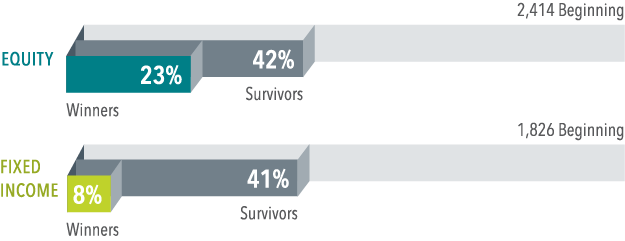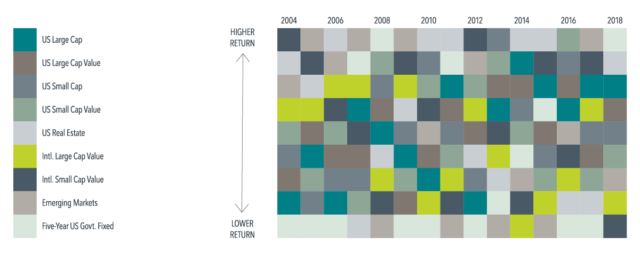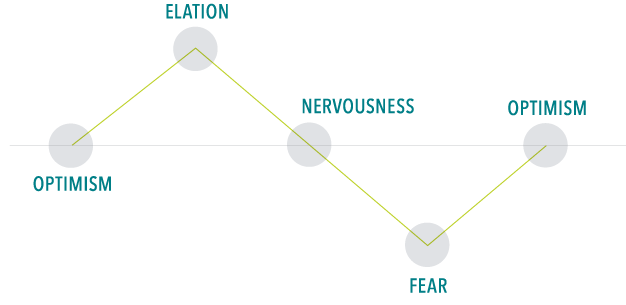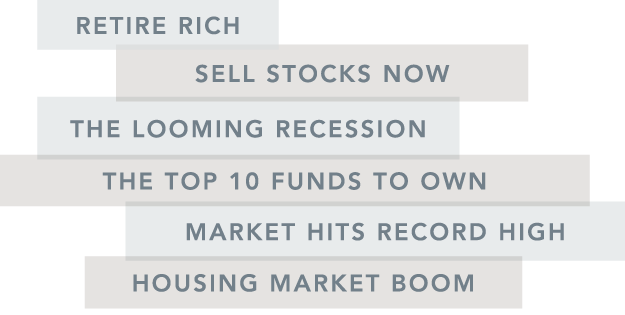Key Questions Guiding Your Long-Term Investing Strategy

At some point on your financial planning journey you’ll likely ask yourself questions regarding how to build and manage your long-term investing strategy. Trying to answer these questions may be intimidating, but know that you’re not alone. While this is not intended to be an exhaustive list it will hopefully shed light on a few key principles, using data and reasoning, to improve your long-term investing strategy.
Key Questions Guiding Your Long-Term Investing Strategy
1. What sort of competition do I face as an investor?
The market is an effective information-processing machine. Millions of market participants buy and sell securities every day and the real-time information they bring helps set prices.
This means competition is stiff and trying to outguess market prices is difficult for anyone, even professional money managers (see question 2 for more on this). This is good news for investors though. Rather than basing an investing strategy on trying to find securities that are priced “incorrectly,” investors can instead rely on the information in market prices to help build their portfolios (see question 5 for more on this).
EXHIBIT 1: Embrace Market Pricing
For More: Embrace Market Pricing
2. What are my chances of picking an investment fund that survives and outperforms?
Flip a coin and your odds of getting heads or tails are 50/50. Historically, the odds of selecting an investment fund that was still around 20 years later are about the same. Regarding outperformance, the odds are worse. The market’s pricing power works against fund managers who try to outperform through stock picking or market timing. One needn’t look further than real-world results to see this. Based on research1, only 23% of US equity mutual funds and 8% of fixed income funds have survived and outperformed their benchmarks over the past 20 years.
EXHIBIT 2: US-Based Mutual Fund Performance 1999-2018

For More: Outguessing the Market – Don’t Try It!
3. If I choose a fund because of strong past performance, does that mean it will do well in the future?
Some investors select mutual funds based on past returns. However, research shows that most funds in the top quartile (25%) of previous five-year returns did not maintain a top-quartile ranking in the following five years. In other words, past performance offers little insight into a fund’s future returns.
EXHIBIT 3: Percentage of Top-Ranked Funds That Stayed on Top

For More: Past Performance – Don’t Chase It!
4. Do I have to outsmart the market to be a successful investor?
Financial markets have rewarded investors with a long-term investing strategy. People expect a positive return on the capital they invest, and historically, the equity and bond markets have provided growth of wealth that has more than offset inflation. Instead of fighting markets, let them work for you.
EXHIBIT 4: Growth of a Dollar 1926–2018 (Compounded Monthly)

For More: Let Markets Work for You
5. Is there a better way to build a portfolio?
Academic research has identified these equity and fixed income dimensions, which point to differences in expected returns among securities. Instead of attempting to outguess market prices, investors can instead pursue higher expected returns by structuring their portfolio around these dimensions.
EXHIBIT 5: Dimensions of Expected Returns
For More: Consider the Drivers of Expected Returns
6. Is international investing for me?
Diversification helps reduce risks that have no expected return, but diversifying only within your home market may not be enough. Instead, global diversification can broaden your investment opportunity set. By holding a globally diversified portfolio, investors are well positioned to seek returns wherever they occur.
EXHIBIT 6: Practice Smart Diversification

For More: Practice Smart Diversification
7. Will making frequent changes to my portfolio help me achieve investment success?
It’s tough, if not impossible, to know which market segments will outperform from period to period.
Accordingly, it’s better to avoid market timing calls and other unnecessary changes that can be costly. Allowing emotions or opinions about short-term market conditions to impact long-term investment decisions can lead to disappointing results.
EXHIBIT 7: Annual Returns by Market Index

For More: Market Timing – Avoid It!
8. Can my emotions affect my investment decisions?
Many people struggle to separate their emotions from investing. Markets go up and down. Reacting to current market conditions may lead to making poor investment decisions.
Avoid Reactive Investing
For More: Separate Emotions From Investing
9. Should I make changes to my portfolio based on what I’m hearing in the news?
Daily market news and commentary can challenge your investment discipline. Some messages stir anxiety about the future, while others tempt you to chase the latest investment fad. If headlines are unsettling, consider the source and try to maintain a long-term perspective.
For More: Look Beyond Investment Headlines
10. So, what should I be doing?
For do-it-yourself investors, do your homework! Be wary of financial salespeople.
For all others, work closely with a financial advisor who can offer expertise and guidance to help you focus on actions that add value. Working with a fiduciary financial advisor is an important consideration as they will always put your best interests first. A financial advisor can help you focus on what you can control can lead to a better investment experience.
- Build a financial plan focusing on your goals
- Create an investment plan to fit your financial plan, needs and risk tolerance.
- Rebalance according to your investment plan
- Structure a portfolio along the dimensions of expected returns.
- Diversify globally.
- Manage expenses, turnover, and taxes.
- Stay disciplined through market dips and swings.
For More: Control Your Investment Focus
For More:
Learn more about investment management services
Investopedia: 4 Steps To Creating A Better Investment Strategy
Long-Term Investing Strategy Austin, TX
FOOTNOTES
1. Mutual Fund Landscape 2019, Dimensional Fund Advisors. See Appendix for important details on the study. Past performance is no guarantee of future results.
APPENDIX
Question 2: The sample includes funds at the beginning of the 20-year period ending December 31, 2018. Each fund is evaluated relative to its respective primary prospectus benchmark as of the end of the evaluation period. Surviving funds are those with return observations for every month of the sample period. Winner funds are those that survived and whose cumulative net return over the period exceeded that of their respective primary prospectus benchmark. Loser funds are funds that did not survive the period or whose cumulative net return did not exceed that of their respective primary prospectus benchmark. Where the full series of primary prospectus benchmark returns is unavailable, funds are instead evaluated relative to the Morningstar category index assigned to the fund’s category at the start of the evaluation period.
Question 3: This study evaluated fund performance persistence over rolling periods from 1999 through 2018. Each year, funds are sorted within their category based on their previous five-year total return. Those ranked in the top quartile (25%) of returns are evaluated over the following five-year period. The chart shows the average percentage of top-ranked equity and fixed income funds that kept their top ranking in the subsequent period.
Questions 2 and 3: US-domiciled open-end mutual fund data is from Morningstar. Equity fund sample includes the Morningstar historical categories: Diversified Emerging Markets, Europe Stock, Foreign Large Blend, Foreign Large Growth, Foreign Large Value, Foreign Small/Mid Blend, Foreign Small/Mid Growth, Foreign Small/Mid Value, Global Real Estate, Japan Stock, Large Blend, Large Growth, Large Value, Mid-Cap Blend, Mid-Cap Growth, Mid-Cap Value, Miscellaneous Region, Pacific/Asia ex-Japan Stock, Real Estate, Small Blend,
by Brian Fry CFP®
Safe Landing Financial is a Los Angeles, CA fee-only financial advisor providing financial planning, retirement planning and investment management to tech professionals and pre-retirees. When you work with Safe Landing Financial, you work with Brian Fry, a fiduciary and CERTIFIED FINANCIAL PLANNER™ that puts clients’ best interests first. Financial planning services include: retirement planning, charitable giving, asset protection, estate planning, saving for college, debt management, tax strategy and investment management. Safe Landing Financial serves as a virtual fee-only financial advisor to individuals and families nationwide.





